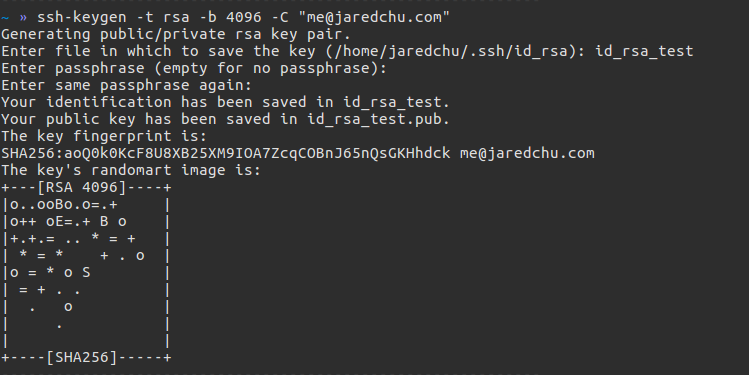Python Rsa Generate Key Pair
Def generatekey(bits): 'Generate a paramiko RSAKey' # NOTE(dims): pycryptodome has changed the signature of the RSA.generate # call. Specifically progressfunc has. Complete the steps in Using Key Pair Authentication to: Generate a new private and public key set. Assign the public key to the user. Set the public key value to either RSAPUBLICKEY or RSAPUBLICKEY2 (whichever key value is not currently in use).
- How to generate public/private key in C#. Asymmetric cryptography also known as public-key encryption uses a public/private key pair to encrypt and decrypt data. In.NET, the RSACryptoServiceProvider and DSACryptoServiceProvider classes are used for asymmetric encryption.
- Sep 30, 2019 To generate RSA keys using the RSAGenerateKeys function, call it in the following sequence of steps: Establish the pseudorandom number generator and prime number generator. Define the RSA private key type 2 in successive calls to the RSAGetSizePrivateKeyType2 and RSAInitPrivateKeyType2 functions with desired values of factorPBitSize.
Chilkat • HOME • Android™ • Classic ASP • C • C++ • C# • Mono C# • .NET Core C# • C# UWP/WinRT • DataFlex • Delphi ActiveX • Delphi DLL • Visual FoxPro • Java • Lianja • MFC • Objective-C • Perl • PHP ActiveX • PHP Extension • PowerBuilder • PowerShell • PureBasic • CkPython • Chilkat2-Python • Ruby • SQL Server • Swift 2 • Swift 3/4 • Tcl • Unicode C • Unicode C++ • Visual Basic 6.0 • VB.NET • VB.NET UWP/WinRT • VBScript • Xojo Plugin • Node.js • Excel • Go
Python Cryptography Generate Rsa Key Pair

| CkPython example code showing how to generate an RSA public/private key pair and export to PEM files.
| |||||
© 2000-2020 Chilkat Software, Inc. All Rights Reserved.

Several tools exist to generate SSH public/private key pairs. The following sections show how to generate an SSH key pair on UNIX, UNIX-like and Windows platforms. /avg-license-key-generator-2015.html.
Python Openssl Generate Rsa Key Pair
Generating an SSH Key Pair on UNIX and UNIX-Like Platforms Using the ssh-keygen Utility
Rsa_generate_key_ex Example
UNIX and UNIX-like platforms (including Solaris and Linux) include the ssh-keygen utility to generate SSH key pairs.
Python Rsa Key Generation
- Navigate to your home directory:
- Run the ssh-keygen utility, providing as
filenameyour choice of file name for the private key:The ssh-keygen utility prompts you for a passphrase for the private key.
- Enter a passphrase for the private key, or press Enter to create a private key without a passphrase:
Note:
While a passphrase is not required, you should specify one as a security measure to protect the private key from unauthorized use. When you specify a passphrase, a user must enter the passphrase every time the private key is used.
The ssh-keygen utility prompts you to enter the passphrase again.
- Enter the passphrase again, or press Enter again to continue creating a private key without a passphrase:
- The ssh-keygen utility displays a message indicating that the private key has been saved as
filenameand the public key has been saved asfilename.pub. It also displays information about the key fingerprint and randomart image.
Generate Rsa Public Key
Generating an SSH Key Pair on Windows Using the PuTTYgen Program
Python Rsa Generate Key Pair Linux
The PuTTYgen program is part of PuTTY, an open source networking client for the Windows platform.
Python Rsa.generate
Python Rsa Generate Key Pair Key
- Download and install PuTTY or PuTTYgen.
To download PuTTY or PuTTYgen, go to http://www.putty.org/ and click the You can download PuTTY here link.
- Run the PuTTYgen program.
- Set the Type of key to generate option to SSH-2 RSA.
- In the Number of bits in a generated key box, enter 2048.
- Click Generate to generate a public/private key pair.
As the key is being generated, move the mouse around the blank area as directed.
- (Optional) Enter a passphrase for the private key in the Key passphrase box and reenter it in the Confirm passphrase box.
Note:
While a passphrase is not required, you should specify one as a security measure to protect the private key from unauthorized use. When you specify a passphrase, a user must enter the passphrase every time the private key is used.
- Click Save private key to save the private key to a file. To adhere to file-naming conventions, you should give the private key file an extension of
.ppk(PuTTY private key).Note:
The.ppkfile extension indicates that the private key is in PuTTY's proprietary format. You must use a key of this format when using PuTTY as your SSH client. It cannot be used with other SSH client tools. Refer to the PuTTY documentation to convert a private key in this format to a different format. - Select all of the characters in the Public key for pasting into OpenSSH authorized_keys file box.
Make sure you select all the characters, not just the ones you can see in the narrow window. If a scroll bar is next to the characters, you aren't seeing all the characters.
- Right-click somewhere in the selected text and select Copy from the menu.
- Open a text editor and paste the characters, just as you copied them. Start at the first character in the text editor, and do not insert any line breaks.
- Save the text file in the same folder where you saved the private key, using the
.pubextension to indicate that the file contains a public key. - If you or others are going to use an SSH client that requires the OpenSSH format for private keys (such as the
sshutility on Linux), export the private key:- On the Conversions menu, choose Export OpenSSH key.
- Save the private key in OpenSSH format in the same folder where you saved the private key in
.ppkformat, using an extension such as.opensshto indicate the file's content.